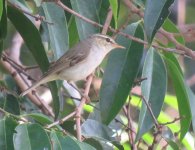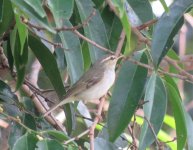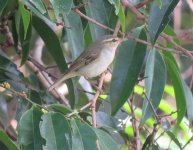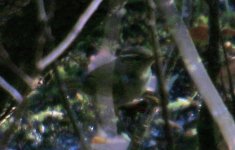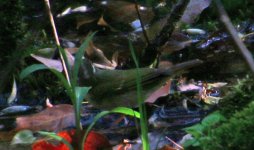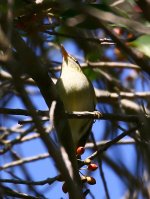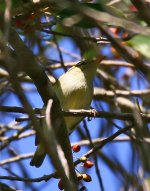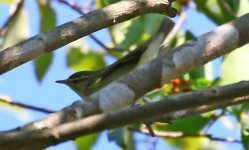I'm very hesitant to post on a thread where all the other contibutors are so distinguished, and I stress I am not suggesting or challenging any ID. But given that two or three of these distinguished contributors went at first for Eastern Crowned Warbler, I would like to give a couple of observations just 'as is'.
Where I live in central Japan (near Osaka), in my local spot, we get Arctic (Kamchatka only as far as I can discover, fairly common on transit), Eastern Crowned (occasionalon transit) and Sakhalin Leaf (once, I think). I would like to stress 'my local spot' which is only a couple of kilometres around. Eastern Crowned can be found reliably in other nearby locations, and Sakhalin Leaf is not especially rare either. By which I mean to say, there aren't many possible alternatives for confusion.
My experience of ECW is that it moves higher up generally than Kamchatka Leaf, and is therefore more difficult to get a good ID photo of.
When I looked at the photo Tib first posted (and also the later ones), one thing that stood out was that the supercilium in front of the eye seemed to be thicker than that behind the eye, whereas ECW is supposed to have a super which narrows in front of the eye. This is mentioned in the books, and has been my experience also, and I think can be seen in the photos I attach, especially the two of the first bird.
The colouration of ECW depends on season and on the light to quite an extent, it seems to me. In the two photos I have attached of a bird I saw last week in a dark area, you can see that the head pattern is very contrasty and unmistakeable. Also notice that the overall greyish head colouration is very distinct from the greenish back.
But in the other photos of an autumn bird (all three same bird), the crown stripe is difficult to see. And the photos showing the underbill were taken a couple of seconds apart. One shows the extremely yellow underbill which is distinctive of ECW, but the second shows that if the angle of the light changes, there is a darker patch which can appear black.
To repeat, I simply offer these as observations.




